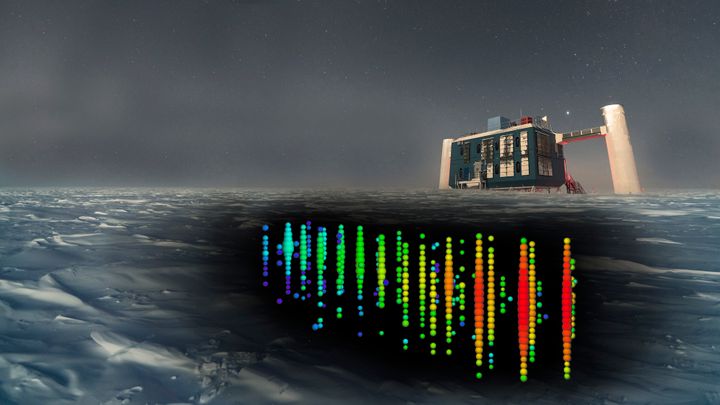Scientists on the hunt for evidence of quantum gravity’s existence at the South Pole
University of Copenhagen team contributes to an Antarctic large-scale experiment striving to find out if gravity also exists at the quantum level. An extraordinary particle able to travel undisturbed through space seems to hold the answer.

Several thousand sensors distributed over a square kilometer near the South Pole are tasked with answering one of the large outstanding questions in physics: does quantum gravity exist? The sensors monitor neutrinos – particles with no electrical charge and almost without mass – arriving at the Earth from outer space. A team from the Niels Bohr Institute (NBI), University of Copenhagen, have contributed to developing the method which exploits neutrino data to reveal if quantum gravity exists.
“If as we believe, quantum gravity does indeed exist, this will contribute to unite the current two worlds in physics. Today, classical physics describes the phenomena in our normal surroundings such as gravity, while the atomic world can only be described using quantum mechanics. The unification of quantum theory and gravitation remains one of the most outstanding challenges in fundamental physics. It would be very satisfying if we could contribute to that end,” says Tom Stuttard, Assistant Professor at NBI.
Tom Stuttard is co-author of a scientific article published [today] by the prestigious journal Nature Physics. The article presents results from a large study by the NBI team and American colleagues. More than 300,000 neutrinos have been studied. However, these are not neutrinos of the most interesting type originating from sources in deep space. The neutrinos in this study were created in the Earth’s atmosphere, as high-energy particles from space collided with Nitrogen or other molecules.
“Looking at neutrinos originating from the Earth’s atmosphere has the practical advantage that they are by far more common than their siblings from outer space. We needed data from many neutrinos to validate our methodology. This has been accomplished now. Thus, we are ready to enter the next phase in which we will study neutrinos from deep space,” says Tom Stuttard.
Travelling undisturbed through the Earth
The IceCube Neutrino Observatory is situated next to the Amundsen-Scott South Pole Station in Antarctica. In contrast to most other astronomy and astrophysics facilities, IceCube works the best for observing space at the opposite side of the Earth, meaning the Northern hemisphere. This is because while the neutrino is perfectly capable of penetrating our planet – and even its hot, dense core – other particles will be stopped, and the signal is thus much cleaner for neutrinos coming from the Northern hemisphere.
The IceCube facility is operated by the University of Wisconsin-Madison, USA. More than 300 scientists from countries around the world are engaged in the IceCube collaboration. University of Copenhagen is one of more than 50 universities having an IceCube center for neutrino studies.
Since the neutrino has no electrical charge and is nearly massless, it is undisturbed by electromagnetic and strong nuclear forces, allowing it to travel billions of lightyears through the Universe in its original state.
The key question is whether the properties of the neutrino are in fact completely unchanged as it travels over large distances or if tiny changes are notable after all.
“If the neutrino undergoes the subtle changes that we suspect, this would be the first strong evidence of quantum gravity,” says Tom Stuttard.
The neutrino comes in three flavors
To understand which changes in neutrino properties the team is looking for, some background information is called for. While we refer to it as a particle, what we observe as a neutrino is really three particles produced together, known in quantum mechanics as superposition. The neutrino can have three fundamental configurations - flavors as they are termed by the physicists - which are electron, muon, and tau. Which of these configurations we observe changes as the neutrino travels, a truly strange phenomenon known as neutrino oscillations. This quantum behavior is maintained over thousands of kilometers or more, which is referred to as quantum coherence.
“In most experiments, the coherence is soon broken. But this is not believed to be caused by quantum gravity. It is just very difficult to create perfect conditions in a lab. You want perfect vacuum, but somehow a few molecules manage to sneak in etc. In contrast, neutrinos are special in that they are simply not affected by matter around them, so we know that if coherence is broken it will not be due to shortcomings in the man-made experimental setup,” Tom Stuttard explains.
Many colleagues were sceptical
Asked whether the results of the study published in Nature Physics were as expected, the researcher replies:
“We find ourselves in a rare category of science projects, namely experiments for which no established theoretical framework exists. Thus, we just did not know what to expect. However, we knew that we could search for some of the general properties we might expect a quantum theory of gravity to have.”
“Whilst we did have hopes of seeing changes related to quantum gravity, the fact that we didn’t see them does not exclude at all that they are real. When an atmospheric neutrino is detected at the Antarctic facility, it will typically have travelled through the Earth. Meaning approximately 12,700 km - a very short distance compared to neutrinos originating in the distant Universe. Apparently, a much longer distance is needed for quantum gravity to make an impact, if it exists,” says Tom Stuttard, noting that the top goal of the study was to establish the methodology:
“For years, many physicists doubted whether experiments could ever hope to test quantum gravity. Our analysis shows that it is indeed possible, and with future measurements with astrophysical neutrinos, as well as more precise detectors being built in the coming decade, we hope to finally answer this fundamental question.”
Kontakter
Tom Stuttard
Assistant Professor
Niels Bohr Institute
University of Copenhagen
+45 31 36 82 18
thomas.stuttard@nbi.ku.dk
Michael Skov Jensen
Journalist og teamkoordinator
Det Natur- og Biovidenskabelige Fakultet
Københavns Universitet
msj@science.ku.dk
+45 93 56 58 97
Følg pressemeddelelser fra Københavns Universitet - Det Natur- og Biovidenskabelige Fakultet
Skriv dig op her, og modtag pressemeddelelser på e-mail. Indtast din e-mail, klik på abonner, og følg instruktionerne i den udsendte e-mail.
Flere pressemeddelelser fra Københavns Universitet - Det Natur- og Biovidenskabelige Fakultet
Vi skal være flexitarer: Skidtfisk og rogn kan gøre grønsagerne mindre kedelige26.4.2024 10:01:42 CEST | Pressemeddelelse
Svaret på en grøn omstilling af vores kostvaner er ikke, at vi alle skal være vegetarer. En sund og mere realistisk løsning er derimod flexitar-kost, hvor det animalske kommer fra havet og giver umami-smag til de ’kedelige’ grøntsager. Sådan lyder det fra gastrofysikeren Ole G. Mouritsen fra Københavns Universitet, som viser, hvordan man med en matematisk ligning kan udregne umami-potentialet i alt fra rogn og rejepasta til blåmuslinger og blæksputter.
Superradiant atoms could push the boundaries of how precisely time can be measured22.4.2024 14:22:28 CEST | Pressemeddelelse
Superradiant atoms can help us measure time more precisely than ever. In a new study, researchers from the University of Copenhagen present a new method for measuring the time interval, the second, mitigating some of the limitations that today’s most advanced atomic clocks encounter. The result could have broad implications in areas such as space travel, volcanic eruptions and GPS systems.
Super-lysende atomer kan skubbe grænsen for hvor præcist vi kan måle tiden22.4.2024 14:07:32 CEST | Pressemeddelelse
Superstrålende atomer kan hjælpe os med at måle tiden mere præcist, end vi kan i dag. I et nyt studie fremlægger forskere fra Københavns Universitet nemlig en ny metode til at måle sekundet, som kommer uden om det problem, som selv de mest avancerede atomure i dag døjer med. Resultatet kan få betydning for så forskellige ting som rumfart, vulkanudbrud og vores GPS-systemer.
Verdens tundra udleder overraskende mere CO2, når det bliver varmere17.4.2024 17:00:00 CEST | Pressemeddelelse
KLAUSULERET TIL DEN 17. APRIL KL. 17:00 Når det bliver varmere, vil den arktiske tundrajord formentlig frigive 30% mere CO2, end den gør i dag. Og det er næsten fire gange mere, end hvad man tidligere har estimeret. Det viser et stort internationalt studie, som forskere fra Københavns Universitet har bidraget til, og som netop er offentliggjort i tidsskriftet Nature.
Internet can achieve quantum speed with light saved as sound15.4.2024 11:16:35 CEST | Press release
Researchers at the University of Copenhagen’s Niels Bohr Institute have developed a new way to create quantum memory: A small drum can store data sent with light in its sonic vibrations, and then forward the data with new light sources when needed again. The results demonstrate that mechanical memory for quantum data could be the strategy that paves the way for an ultra-secure internet with incredible speeds.
I vores nyhedsrum kan du læse alle vores pressemeddelelser, tilgå materiale i form af billeder og dokumenter samt finde vores kontaktoplysninger.
Besøg vores nyhedsrum